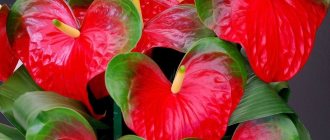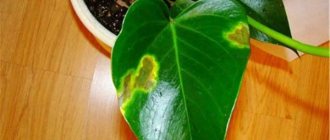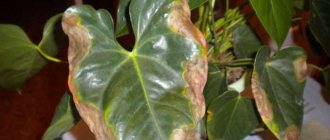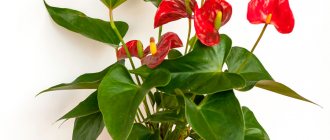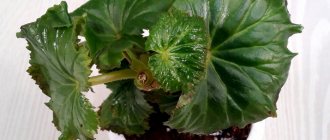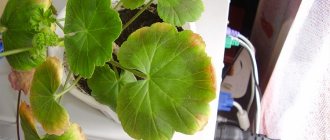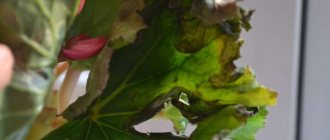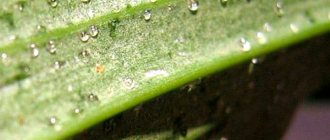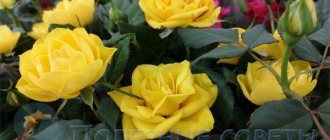Features of care
Anthurium is considered a capricious plant, for the correct growth of which many conditions must be observed. Sometimes even experienced gardeners make mistakes when growing it. The main thing you need to know is that anthurium deteriorates due to direct sunlight, so it needs to be kept in a slightly shaded place or illuminated with fairly bright but diffused artificial light.
The optimal air temperature for plant growth in summer is +20...+24°C, and in winter - +14...+16°C. But in winter there are short daylight hours, so during this time you will have to provide the anthurium with an additional source of lighting. If you ignore this requirement, the plant will inevitably fade. If the question arises as to why anthurium leaves dry and what to do to solve this problem, then you first need to determine whether the following conditions and recommendations are met:
- A plant that stands in a room with dry air must be constantly sprayed with a fine spray bottle. But splashes of water should not be allowed to fall on the inflorescence, as this will cause it to become covered with white spots.
- It is advisable to water the anthurium with slightly warm water. In summer this should be done three times a day, and in winter - once a week.
- The growing season begins in March and ends in October, so during this period you need to fertilize the plant with various nutrients (for example, foliar fertilizers), which must be applied in small portions.
- Faded inflorescences must be cut off, as they form seeds.
- After transplantation, anthurium is extremely sensitive to lack of moisture, so at first it needs to be constantly sprayed and watered.
These are the basic rules, which are the responsibility of the grower. However, if the leaves of the anthurium begin to dry out, what to do to correct this situation must be decided quickly, since in this case there is a high risk of the plant dying.
Brown dry spots on anthurium
If the anthurium is sick. Brown spots on leaves
Many fans of indoor plants have anthurium in their home collection. It is valued for its unusually beautiful flowers and wide shiny leaves. The difficulty in caring for anthurium lies in the need to create and maintain optimal conditions under which the plant will develop well and will not be affected by pests and diseases.
Sometimes gardeners begin to notice how brown dry spots appear on the anthurium, which spoils the appearance of the flower. It should be noted that most diseases are associated with non-compliance with plant care rules.
Features of caring for anthurium
Anthurium is a tropical plant, and therefore requires special conditions for cultivation and care. An important point is to choose the right place where the flower will stand, since it loves light, but direct sunlight is harmful to it. When constantly exposed to such lighting, the leaves begin to curl into a tube.
Drafts are also harmful to the flower. The optimal temperature, which is considered comfortable for the plant, is the range between 20 and 25 degrees Celsius. In addition, the soil must be at the same temperature as the air in the room.
Daily spraying of anthurium is recommended, as it prefers high air humidity. At the same time, you need to try to prevent water from getting on the flowers themselves, otherwise stains may appear on them, which will affect their decorative effect.
Water the plant moderately, making sure that the earthen ball does not dry out, but remains slightly moist. Water for irrigation is used warm and well-settled; stagnation is not allowed.
Causes of spots on plant leaves
Since the plant is afraid of drafts, the result of staying in such conditions will be the appearance of large brown spots. You need to move the flower to a warm place and reduce watering to stop their development.
If the diameter of the spots is not large, then most likely this is a consequence of sunburn. Anthurium should be moved to partial shade, where it will be much more comfortable.
If the leaf blades of the anthurium are completely covered with brown dry spots, and the size of the new growing leaves is much larger than the previous ones, then the reason lies in the excessive amount of fertilizer used to feed the plant.
Sometimes the plant is affected by mealybugs. The above-ground parts of the flower provide an excellent environment for their life. This also leads to brown dry spots appearing on the anthurium. If no pest control measures are taken for a long time, the leaves may fall off. A good remedy for mealybugs is treatment with karbofos.
Yellowing and dying of old anthurium leaves located at the bottom of the plant is a natural process. Sometimes adult plants can lose their attractiveness because of this, so flower growers practice flower rejuvenation.
Fungal diseases of anthurium
The most common fungal disease of anthurium is septoria. With it, the leaf plate is covered with brown spots, along the edges of which there is a noticeable border of a light color, and inside there are dark dots.
In this case, the concentration of substances should be weak.
To ensure that the anthurium blooms abundantly and the leaves are shiny and clean without any stains, you need to be careful when feeding the plant. Fertilizers are applied no more than once every fourteen days. Any universal fertilizer is suitable for fertilizing.
Any universal fertilizer is suitable for fertilizing.
The only thing you should pay attention to is during the flowering period of anthurium; here the priority should be special mixtures for decorative flowering plants, such as “Agricola”, “Fertika-lux”, “Pokon” and others. Particular attention must be paid to the dosage of fertilizers; their concentration should be halved from that recommended on the packaging with the drug. Particular attention must be paid to the dosage of fertilizers; their concentration should be halved from that recommended on the packaging with the drug
Please rate the material you read :)
Particular attention must be paid to the dosage of fertilizers; their concentration should be halved from that recommended on the packaging with the drug. Please rate the material you read :). Please rate the material you read :)
Please rate the material you read :)
(7 rated, score: 5.86 out of 10) Loading...
Causes of drying out
Making a diagnosis and starting treatment for a plant is a difficult task, since most often the disease occurs due to improper care. If anthurium leaves dry out, what should you do to fix it? Few gardeners know the answer to this question. As a rule, such a nuisance occurs when the flower is in a room whose humidity does not correspond to the required level for proper plant growth, equal to 65–80%.
In this case, the anthurium will be attacked by spider mites, which will cause the leaves to lose their fresh appearance, turn yellow and curl. In turn, in rooms without normal ventilation, there is a high probability that the plant will be exposed to an infectious disease.
But there are many other reasons why leaves begin to dry:
- weak or poorly organized watering;
- flower damage by mealybugs or thrips;
- various diseases (for example, anthractic blight or stem rot);
- draft;
- non-compliance with the feeding schedule and excess nutrition;
- dry air;
- lack or excess of lighting, etc.
The result of a long violation of the maintenance rules is a dead plant. Experienced flower growers should definitely know why anthurium leaves dry out. According to them, this can also happen due to an attack by insects, the result of whose harmful activity is a damaged root system of the plant, and consequently, the destruction of the above-ground part. However, it is necessary to take a closer look at the main reasons so that beginners growing anthurium can cure it in a timely manner.
Anthurium is a houseplant that even turns yellow beautifully
It is no coincidence that Anthuriums have been holding the lead for a decade in the list of the most fashionable indoor “universal” plants - plants that have equally good leaves and flowering. They look not just highly decorative, but almost flawless.
The dense texture of large leaves and inflorescences with bright spathes, with all the choice of different colored varieties, seem to be a true modern classic. Anthuriums are so often used in the landscaping of restaurants, coffee shops and offices, they are so extolled that the plant has acquired the reputation of a true Spartan. Although the character of anthurium is very far from such status.
Anthuriums are plants that themselves tell their owners what is wrong with them. They usually do not react to slight deviations for a long time, showing signs of loss of decorativeness only with systemic violations of care or in a completely unsuitable microclimate.
The most common symptom of problems with anthuriums is yellowing of the leaves. The sheets may become covered with bright yellow spots, partially turn yellow, as if watercolor is spreading across the plate, or be completely repainted. At the same time, sometimes the cuttings of the anthurium turn yellow, and sometimes they remain green.
Even after being repainted, the leaves of this plant still remain elastic, hard and shiny for quite a long time. Among all indoor plants, it is the anthurium that exhibits the most decorative yellowing. And one of the easiest “treatments”: if you take timely measures, the plant will quickly restore its usual colors, normal development, and flowering.
If measures are taken in a timely manner, the anthurium will quickly restore its usual colors, normal development, and flowering. gardening
Natural cause: aging
Anthurium leaves may turn yellow due to old age. This is an inevitable process, so don't worry too much about it. With aging, the leaves that are located closer to the ground gradually die off. Yellowness covers the edges of the leaf plate, and then covers the entire leaf, as a result of which it loses its elasticity and turns brown. If the anthurium is kept in proper conditions, the shedding of old leaves is a natural process that does not harm the plant, since new foliage will appear at its top over time.
However, the flower can be helped in some way. To do this, you need to cut off the yellowed old leaves, making the anthurium more attractive and making its life easier. To avoid infecting the plant with an infection, the knife must be treated with alcohol, and the cut area must be sprinkled with a little charcoal. However, do not forget: the leaf cannot be torn off by hand, as this will lead to injury to the stem.
What to do for prevention
Why do hydrangea leaves dry around the edges - what to do and how to revive the flowers
It is easier to prevent damage than to cure a very diseased plant, so periodic prevention is needed. The main preventive actions against diseases come down to following the rules of care and providing the necessary conditions.
Pest prevention measures are described in detail below. It is more difficult to fight them, because they can be brought from the street on clothes or with a new flower.
Healthy anthurium
A number of measures that will reduce the risk of parasite infection:
- all new flowers should be kept away from others for 14 days;
- if the soil seems suspicious, then it is better to transplant the flower into a new one;
- in spring and summer it is worth inspecting the leaves for the presence of parasites at least once every 7 days; in the autumn-winter period you can do this less often;
- once a month you can treat the leaves with a soap solution;
- If there is a suspicion that the plant has pests, it is better to treat it with insecticidal solutions immediately.
Irrigation violation
Anthurium does not tolerate both waterlogging and lack of moisture. The roots of the plant are sensitive to excess water. Moist soil is an ideal environment for bacteria and fungi. In addition, anthurium can only be watered with melted or settled water (settling time is at least two days)
If the plant stays in waterlogged soil for a long time, the tips of the anthurium leaves will begin to dry out. What to do in this unpleasant situation, when tissue necrosis begins to develop from the edges and gradually spreads to the entire leaf? To solve this problem, you need to dry the soil in the pot. If this does not help, it means that the root system of the plant has rotted, so the leaves lack nutrients. There is only one solution - remove the damaged parts and replant the anthurium in fresh soil.
However, the leaves may begin to dry out in the middle. The reason for this may be accidental ingress of water onto the leaf plates. For sunlight, such drops are a kind of lens, so they will simply burn through the living tissue of the plant. In addition, in anthurium that is in a cool room, improper watering can cause fungal disease.
Rot of the stem and root system
In this case, the plant begins to quickly wither; dark depressed spots appear on the basal part of the stem and on the surface of the roots, which are covered with a dense white coating. It's a fungus. Such mold may begin to appear on the leaves. Important: the disease is contagious and can spread to other plants.
What to do: remove from the pot, remove all areas affected by rot, treat the roots with a solution of potassium permanganate and a fungicide (phytocide, phytodoctor), completely replace the soil in the pot, having previously disinfected the pot itself.
Incorrect lighting
It is best to place the anthurium in partial shade. If the plant grows weakly or has stopped blooming altogether, it means that it does not have enough sunlight or artificial light. During the period of short daylight hours, when the anthurium ceases to receive the proper amount of energy, the leaf plates become smaller and dry out a little. In this case, the flower must be placed in a place where more sunlight falls in winter. As a result, the stains will disappear over time.
However, you cannot stay in the direct rays of anthurium for a long time, as this will cause the leaves to turn yellow. According to the recommendations of flower growers, to solve this problem, you need to cover the glass with a tinting film, the purpose of which is to reflect most of the solar radiation. In addition, the plant can be placed away from the glass.
If the tips of the leaves of an anthurium dry out, what should you do to save the plant in winter? Flower growers, when they hear this question, say: it is necessary to provide the flower with an additional source of lighting. For these purposes, special phytolamps or other lamps are used for additional illumination.
Anthurium care video
Anthurium is a bright and unusual epiphyte native to the tropics.
The plant is quite whimsical, but with some experience, patience and attention, you can grow a beautiful bush and wait for amazing flowers that will decorate your home. As a rule, anthurium is grown in greenhouses, but ideal conditions can also be created for it at home. The main thing is to know the main problems and eliminate them in time. You can also share your secrets for caring for anthurium at home. If you have questions, ask them in the comments below, we will be happy to answer them.
Lack or excess of nutrition
If the anthurium suddenly stops growing and its leaves dry out or turn yellow, this may be due to a nutrient deficiency. Lack or absence of phosphorus, potassium, nitrogen, magnesium and other elements will cause the plant to turn brown.
Special ready-made liquid products are used as fertilizers. Thanks to their effect, the diseased anthurium will restore its healthy and blooming appearance. These medications should be used weekly. As soon as the plant acquires its former strength, mineral fertilizing is applied once every 14 days.
However, not only a deficiency, but also an excess of fertilizers can be the reason why anthurium leaves dry out. In this case, the root system must be washed in warm water and treated with a disinfectant, and then the plant must be transplanted into a pot with new soil.
How to prevent leaves from drying out
It is much easier to organize suitable conditions for anthurium than to then treat a drying bush. Thus, for the plant to feel comfortable, it is necessary:
- Place the pot on eastern or western window sills in the summer, and move it to the southern ones in winter;
- Water the flower moderately, only after the substrate has dried;
- Organize a high-quality drainage system for water drainage by making holes at the bottom and placing a drainage layer in the pot (1/3 of the total height);
- Avoid direct sunlight on the leaves;
- Spray the bush and wash it regularly;
- Use suitable soil with the required acidity (5.5-6.5 pH).
Timely replanting (once a year) with a change of substrate will help avoid nutrient deficiency and maintain the health of the flower.
Dry air
This is a fairly common problem in homes with central heating. If the tips of the leaves of an anthurium dry out, the plant may lack moisture, because it evaporates too quickly in a heated room. More often this happens when the flower stands on a wide windowsill, under which a heating radiator is installed. There are several ways to increase humidity and improve the microclimate of the room for better growth of anthurium:
- Place the pot with the plant on a tray with damp expanded clay or sphangum (another name is peat moss).
- Constantly spray the leaves with warm water so that the drops do not fall on the inflorescences.
- Place a special humidifier next to the anthurium.
- Place a container of water near the battery or place a wet towel over it.
In any case, placing an anthurium near a heating device is a bad idea. In addition, you should not water the plant frequently to increase the humidity in the room.
What is the name of the flower of male happiness, what does it look like?
The flamingo flower fits perfectly into the modern interior of a home or office, emphasizing its laconicism and harmonious atmosphere.
Florists often use anthurium in flower arrangements because cut flowers can stay fresh for up to five weeks.
Anthurium can bloom all year long
A plant with bright flames, which form an inflorescence-cob, with velvety dark green leaves. An arrow-shaped or heart-shaped bract, like a blanket, wraps the cob. The plant can reach 40 cm in height
With bright scarlet stipule color
What is an anthurium inflorescence? It is a spadix surrounded by a showy shiny bract that is pink, brown, white spotted, yellow or fiery red.
With purple stipule
White anthurium inflorescence
Brown
Pink stipule with green edge
Anthurium blooms in March and can delight with flowering for 7-8 months. Each individual inflorescence blooms for 1-1.5 months.
Only in good conditions does an exotic plant grow up to 0.8 m in height. Anthurium can reach 0.5 m in diameter
Only a healthy and well-groomed plant will help solve problems in your personal life.
In the American tropics and subtropics, anthurium grows in the wild and is an epiphyte (attached to other plants). But in our weather conditions, the flamingo flower will feel comfortable only in heated rooms. An elegant flower requires special care
Anthurium in the wild
Draft and cold
If the leaves of an anthurium dry out, what should you do (the photo shows a clear example of this problem) to save the plant? Flower growers answer: you cannot place a flower pot near the balcony door, which residents often open in winter. If you ignore this advice, there is a high probability that the anthurium leaves will dry out. To protect the plant from drafts and cold air, it must be taken out of the room for ventilation.
If the leaves of the anthurium are slightly frozen, the plant can be restored. All damaged organs of the flower must be carefully cut off and placed in a warm room. The next step is to treat the plant with a biogrowth stimulator. However, the root may be damaged, so in this case you will have to replant the anthurium after cutting off the rotten areas. It is advisable to treat the cut areas with cinnamon.
Brown spots on anthurium leaves: why they appear and how to get rid of them
A plant called anthurium is known to almost all gardeners. Due to the beautiful combination of green leaves and red flowers of the original shape, it is often called the flamingo flower. This is one of my favorite "pets" that does not require much care or attention. But recently I began to notice that brown spots began to appear on the plant's usually smooth and bright leaves.
I didn’t want to lose such beauty, and I immediately began to look for the cause of the problem, which I succeeded in quite quickly. If you had to face a similar situation, I will tell you how to save a flower from death and return it to its original appearance.
Anthurium leaves dry out in patches due to pests: what to do
The plant may turn yellow not only due to improper maintenance conditions. An equally common cause is leaf damage by various pests:
- When the anthurium becomes covered with yellow spots and begins to dry out sharply, you must immediately inspect the underside of the leaf plate. If small insects of green, black or gray colors are visible there, it means that the plant has been attacked by aphids. They feed on the sap of leaves. To save the plant and destroy aphids, you need to treat the anthurium with an infusion of garlic, onion or tobacco. But it is better to use chemicals - insecticides.
- The presence of thrips - insects similar to small flies - on the plant is indicated by dried leaves of a yellowish-white color. Various drugs (for example, Intavir or Fitoverm) and sticky traps are used against them.
- If the leaves are covered with spots and the shoots are covered with cracks, it means that the plant has been affected by mealybugs. To eliminate them, karbofos is used.
- Due to spider mites attacking the anthurium, the leaves dry out in the middle. What to do to destroy these pests? It is necessary to use insecticides against ticks, otherwise the leaves will quickly dry out and turn yellow.
The main thing is to clean the anthurium with water a day after the chemical treatment to protect the plant from toxic substances. But first you need to protect the soil from excess moisture with plastic film.
Brown dry spots on anthurium
If the anthurium is sick. Brown spots on leaves
Many fans of indoor plants have anthurium in their home collection. It is valued for its unusually beautiful flowers and wide shiny leaves. The difficulty in caring for anthurium lies in the need to create and maintain optimal conditions under which the plant will develop well and will not be affected by pests and diseases.
Sometimes gardeners begin to notice how brown dry spots appear on the anthurium, which spoils the appearance of the flower. It should be noted that most diseases are associated with non-compliance with plant care rules.
Features of caring for anthurium
Anthurium is a tropical plant, and therefore requires special conditions for cultivation and care. An important point is to choose the right place where the flower will stand, since it loves light, but direct sunlight is harmful to it. When constantly exposed to such lighting, the leaves begin to curl into a tube.
Drafts are also harmful to the flower. The optimal temperature, which is considered comfortable for the plant, is the range between 20 and 25 degrees Celsius. In addition, the soil must be at the same temperature as the air in the room.
Daily spraying of anthurium is recommended, as it prefers high air humidity. At the same time, you need to try to prevent water from getting on the flowers themselves, otherwise stains may appear on them, which will affect their decorative effect.
Water the plant moderately, making sure that the earthen ball does not dry out, but remains slightly moist. Water for irrigation is used warm and well-settled; stagnation is not allowed.
Causes of spots on plant leaves
Since the plant is afraid of drafts, the result of staying in such conditions will be the appearance of large brown spots. You need to move the flower to a warm place and reduce watering to stop their development.
If the diameter of the spots is not large, then most likely this is a consequence of sunburn. Anthurium should be moved to partial shade, where it will be much more comfortable.
If the leaf blades of the anthurium are completely covered with brown dry spots, and the size of the new growing leaves is much larger than the previous ones, then the reason lies in the excessive amount of fertilizer used to feed the plant.
Sometimes the plant is affected by mealybugs. The above-ground parts of the flower provide an excellent environment for their life. This also leads to brown dry spots appearing on the anthurium. If no pest control measures are taken for a long time, the leaves may fall off. A good remedy for mealybugs is treatment with karbofos.
Yellowing and dying of old anthurium leaves located at the bottom of the plant is a natural process. Sometimes adult plants can lose their attractiveness because of this, so flower growers practice flower rejuvenation.
Fungal diseases of anthurium
The most common fungal disease of anthurium is septoria. With it, the leaf plate is covered with brown spots, along the edges of which there is a noticeable border of a light color, and inside there are dark dots.
In this case, the concentration of substances should be weak.
To ensure that the anthurium blooms abundantly and the leaves are shiny and clean without any stains, you need to be careful when feeding the plant. Fertilizers are applied no more than once every fourteen days
Any universal fertilizer is suitable for fertilizing.
Any universal fertilizer is suitable for fertilizing.
The only thing you should pay attention to is during the flowering period of anthurium; here the priority should be special mixtures for decorative flowering plants, such as “Agricola”, “Fertika-lux”, “Pokon” and others. Particular attention must be paid to the dosage of fertilizers; their concentration should be halved from that recommended on the packaging with the drug
Particular attention must be paid to the dosage of fertilizers; their concentration should be halved from that recommended on the packaging with the drug
Please rate the material you read :)
Particular attention must be paid to the dosage of fertilizers; their concentration should be halved from that recommended on the packaging with the drug. Please rate the material you read :)
Please rate the material you read :)
Please rate the material you read :)
(7 rated, score: 5.86 out of 10) Loading...
Infectious diseases
If the leaves of an anthurium dry out, the flower needs to be isolated from healthy plants, examined and a final diagnosis made. The following diseases exist:
- Root rot occurs due to low soil acidity and constant waterlogging. With this disease, the leaves of the anthurium will begin to fade. To save the plant, it must be promptly transplanted into new soil, cutting off the rotten parts of the root system and washing it with a solution of potassium permanganate. It is advisable to add perlite to fresh soil to distribute moisture in the soil.
- Stem rot is a fungal disease that causes black spots to appear on leaves and stems. More often this disease occurs due to increased soil moisture. To save the anthurium, you need to cut off the rotten parts, and then treat the flower with fungicides (for example, Fitosporin).
- Anthracticosis is an infection that often occurs at elevated temperatures (more than 25°C) and humidity. The leaves will suffer more severely: dry spots will appear on them, which may crack. If the plant is not cured, its ground part will become completely covered with ulcers, which will cause the death of the flower. In case of anthractic disease, you need to reduce watering and spray the anthurium with fungicidal preparations.
Anthracnose
This is another dangerous disease caused by Colletorichum fungi. What are the signs of a disease affecting anthurium? The leaves, petioles and stems dry out, the entire plant is quickly affected by spores and may die within a month. Most of the flower can be saved if treatment is started after the first symptoms appear. First, brown spots appear, on which dark spores are visible up close. Over time, the small patchy areas enlarge to become a solid dry area. Anthracose flows especially rapidly in a greenhouse atmosphere, that is, with high humidity and heat. The danger is that the fungus spreads to healthy areas with water when watering and spraying.
If anthurium has been exposed to disease, treatment should be as follows:
- reduce watering or not water at all for 1-2 weeks;
- add special products to the water for spraying (copper oxychloride solution or copper sulfate 100 g per 2 liters of water);
- trim off all leaves with brown spots;
- if necessary, it is necessary to treat the soil with disinfectants (Abiga-Pik at 5 g per 1 l);
- if the flower is seriously damaged and treatment is unsuccessful, it must be burned, since there is a high probability of anthracosis spreading to other plants.
How to save plants?
Sometimes it happens that no matter how carefully the grower cares for the flower, it still looks sick.
In this case, the problem may lie in unnecessary concern on the part of the person, that is, he begins to feed the flower with fertilizers, fill it with water, or place it in a place where there is too much light for it. To detect pests, you can visually inspect the soil and leaves, sometimes you will need a magnifying glass. Any change in green color already indicates that something is going wrong. If you smell the soil, then with root rot it acquires a special, pungent and unpleasant odor. In most cases, it is possible to revive the plant, but to do this you need to act quickly. If the bushes are infected with insects, any of those previously described, then their treatment comes down to increasing humidity and using fungicides. Neem oil is very effective. According to plant growers, a decoction of onion peels or even an alcohol solution helps a lot. The simplest method is to dilute the soap in water and spray the flower.
Reanimation with root rot is more difficult - it’s not enough to just spray. You will need to proceed step by step in the following sequence:
- first remove the root system;
- rinse it under water;
- remove all infected shoots;
- treat the roots with a fungicide;
- change the pot or disinfect the old one in a bleach solution;
- use new soil, and subsequently strictly monitor the quality of drainage and soil moisture.
If you do everything correctly, you can cure the flower, but if you start an infection, it will die.
You can save anthurium, just like Magnificum, by treating it with insecticides and fungicides, but it is only recommended to spray chemicals on the street. Pyrethrin helps a lot. This active ingredient is obtained from the chrysanthemum plant.
Some problems are not easy to deal with, so it is better to take preventive measures.
Pests
Why do Chinese rose leaves or hibiscus disease turn yellow?
Indoor anthurium, in addition to diseases, can dry out or rot under the influence of insects: aphids, thrips, spider mites, scale insects or whiteflies. If pests appear, you will need a soap solution or insecticide; you will have to treat the crop once every 2-3 days.
Aphid
It is easy to recognize that anthurium is infested with aphids by yellow, curled leaves, sticky secretions, and the plant begins to quickly die. The simplest pest control measure is a warm shower or spraying the plant with a soap solution (20 g of laundry soap per 6 liters of warm water). A more effective solution would be to use drugs: “Antitlin”, “Aktara”, “Aktellik”.
Aphids on anthurium
Thrips
Leaves affected by thrips are covered with light yellow spots of various parameters and shapes. The parasites are located at the bottom of the leaves and are distinguished by a brown tint. The danger of thrips is achieved by the spread of the rust virus. The optimal environment for unwanted guests is high humidity and temperature. It is necessary to adjust the indoor climate. Highly toxic drugs will help treat a flower affected by thrips: Tanrek, Actellik or Fufanon.
Spider mite
Spider mites are identified by small yellow specks on the outside of leaves that merge into huge spots. A cobweb appears at the bottom of the leaf, full of small insects. Ticks love high temperatures and dry air. As soon as the flower turns yellow, it is important to immediately treat the leaves with soapy water, clean them of insects and wipe them with mineral oil. Adjust humidity and temperature conditions.
Shchitovka
Whitish or golden-brown tubercles on anthurium leaves are the first signs of a scale insect sucking out the vital juices of a home flower. An ordinary needle will allow you to remove the pest from the leaf. Single specimens are also cleaned with a toothbrush and wiped with a cotton swab soaked in kerosene - the scale insect will suffocate under the kerosene film.
On a note! Often, gardeners experiment with an oil-based spray to polish anthurium leaves. If parasites are actively multiplying, you should make an insecticidal solution and prepare mineral oils for treating greens.
Whitefly
The flower looks depressed, the leaves curl and become discolored, the buds and flowers fall off. It is worth carefully examining your pet, especially the underside of the leaves. Perhaps the plant has become a haven for insect pests - whiteflies. Small moths with many larvae suck out the vital juices of the anthurium. The consistency of whitefly secretions on the upper part of the leaf resembles a sticky shiny coating, similar to sugary stains. When whiteflies appear, experts advise resorting to the use of chemicals: “Aktara”, “Confidor”, “Akarin”, “Iskra”, “Fitoverm”, “Aktellik”, “Tanrek”.
Whitefly on a healthy plant
Anthurium planting seeds and care at home. How to grow anthurium from seeds from China?
You ordered anthurium seeds from China - how to grow a beautiful flower? In today's article you will find out whether there is a difference between anthurium seeds from China and how to grow it from seeds at home?
How to grow anthurium from seeds from China?
Read reviews before purchasing seeds. Are there any negative ones, find a seed variety that is in demand among gardeners. Write to the supplier and find out about the timing of seed collection, quality, and characteristics of the variety. After ordering, buy a container for planting and learn basic anthurium care at home.
How to care for anthurium at home:
- Air temperature during the rest period is +15° C, in a greenhouse or conservatory +25° C;
- Air humidity 85%;
- Regular watering and spraying;
- Loosening and fertilizing the soil;
- Placement in a bright place without direct sunlight - western, south-eastern windows;
Growing anthurium from seeds from China
We prepare the arrived seeds before planting them in the soil mixture. Growing anthurium with seeds makes it possible to get many seedlings of unique varieties and try your hand at planting from scratch.
Preparing anthurium seeds before planting:
- Mash the seed shell, if there is one;
- Remove the material for sowing and rinse;
- Soak in a 0.1% solution of potassium permanganate;
After treatment, dry the anthurium seeds - plant them only dry, otherwise the seed will rot in the soil. In the meantime, we begin preparing the soil mixture.
Soil for planting anthurium:
- Perlite;
- Peat;
- Pine Mountain;
Mix the ingredients in a 1:1:1 ratio and add 3 parts of gravel. An alternative is to use a universal substrate mixed with vermiculite. Be sure to add perlite. It can be replaced with sphagnum moss. The seeds germinate in rough soil with good drainage.
How to grow anthurium from seeds from China:
- Moisten the soil mixture.
- Spread the seeds over the surface.
- Cover with clear glass/film.
- Place in temperature conditions of 22-25° C.
- After 2 weeks, open the glass/film and the first shoots will appear.
The rate at which seeds hatch and sprouts appear depends on the variety and germination conditions. Wait until 5 leaves appear on the seedlings, then plant the anthurium from seeds from China into separate containers. The soil in individual pots should be close to the complex mixture for an adult plant. The volume of the soil mixture is 150 ml. Plant 200 ml pots when the seedlings are 7 cm in height.
Tricks for growing anthurium from seeds from China: planting seeds or seedlings in a spacious container will slow down their development. Anthurium germinates faster if the pot volume is small and the soil mixture is well drained. Excessive moisture in the soil mixture leads to rot or acidification of the soil. Pure varieties of anthurium grow better, while hybrids may not take root, although they differ in the variety of rosettes, heights and shapes. Air humidity 80-85% is the ideal condition for keeping anthurium. It can be increased by spraying the plant, indoors or by placing the flower in a greenhouse or greenhouse. Many gardeners place anthurium in the bathroom to maintain the microclimate. Dry air and placement near heaters destroy the plant.
↓ Write in the comments how you grew anthurium from seeds from China? Send photos of planted plants.
How to rejuvenate anthurium
Rejuvenation occurs in two ways:
- activating aerial roots;
- restoring the functionality of the root system.
Aerial roots will begin to develop in a warm and humid environment. Therefore, the best way is to place the plant in a warm place and create a belt of sphagnum moss around the growth points of future roots. In a constantly moist substrate, the plant will take root within a week or two. Then this part can be cut off with a sharp, disinfected knife, sprinkled with crushed charcoal or ground cinnamon.
Such a seedling can be immediately rooted in a pot by preparing the necessary composition of tropical soil. Sphagnum will not interfere with this; the roots will break through the pores of the moss and reach the nutrient mixture.
But if the plant is very elongated, then in this way you can root another piece of the plant stem. During root growth, the plant is not watered so as not to spoil the idle soil. It is only sprayed from above. As a harbinger of the salvation of the anthurium, a new leaf will soon appear on the seedling. After this, create conditions for the anthurium to develop as quickly as possible. The plant will not need feeding for the first 2-3 months, the soil is full, but there are still few roots.
In order to thoroughly understand the condition of the rhizomes and understand how to revive the anthurium, you need to carefully wash all the roots, but they are very fragile. Then cut out the rotten and brown parts
If there are growth points on the light-colored roots, they will be visible. Place clean, disinfected and dried roots in a pot with a drainage layer and suitable nutrient soil. The container of the dish must correspond to the size of the root system. If there are few roots left, then the container should be small.
Plant the plant according to all the rules and wait for the result. Such work may not be necessary if only the above-ground part of the anthurium dies, the roots remain viable. Then, after cutting off the top for separate rooting, the entire pot is left at rest in a warm and bright place. After some time, young shoots should appear, which can later be planted. This is also one of the ways to rejuvenate anthurium.
A significant role in the revival of plants is played by subsequent care for them, as for a loved one who is recovering from a serious illness.

